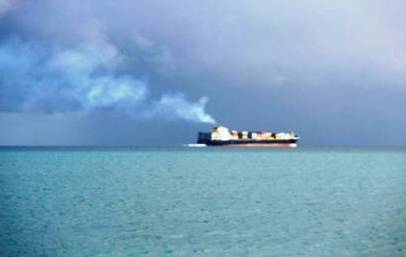The dirty old shipping industry
December 2013/January 2014
Summer is here and we are heading for the coast. We really do hope you enjoy your time at the beach, but as you watch ships pass by, often close by, take note of the plume of filthy smoke they belch out and consider this piece published in Crikey in 2009.
Jenny Warfe, Blue Wedges, writes: Re. "Ship trails stop rainfall in its tracks" http://www.crikey.com.au/2009/10/14/ship-trails-stop-rainfall-in-its-tracks
Ben Sandilands analysis of what the dirty old shipping industry is doing to our global atmosphere sounds an alarm for what the same dirty mob is doing to our local air quality.
As Ben points out, ships burn the dirtiest fuel (bunker oil which is basically the remains of dinosaurs and ancient vegetation) producing high levels of SO 2 and sulphate particulate matter. Furthermore, CO2 emissions from shipping is double aviation, could rise by 75% in the next 15 to 20 years if world trade continues to grow and no action is taken, and is currently double the total emissions from Britain and more than all African countries combined.
Current port expansion plans here and around the world entrench the problem too, and unlike aviation, where airlines can be identified and regulated by country of origin, the shipping industry hides behind flags of convenience, so its emissions are immune from any regulation.
But, as well as all these appalling global atmospheric impacts, shipping emissions are linked to high rates of cardiovascular disease, cancer and asthma. In April 2009, The Guardian reported US research which found pollution from the world's 90,000 cargo ships leads to 60,000 deaths a year in the US alone, and costs up to $330 billion per year in health costs from lung and heart diseases. A new Danish study suggests that shipping emissions cost the Danish health service almost £5 billion a year, mainly treating cancers and heart problems. A previous study estimated that 1000 Danish people die prematurely each year because of shipping pollution. See: http://www.theguardian.com/environment/2009/apr/09/shipping-pollution
Melbournians and bay side residents must be exposed to the same risks from the thousands of shipping movements every year in Port Phillip Bay. In Australia we have advanced as far as doing a study on the Greenhouse Gas emissions from shipping in two port regions -Fremantle and Brisbane. As far as we know though, no Australian studies have been done on other powerful pollutants with known health impacts from shipping emissions
Californian legislation now requires ships burning bunker oil to stay at least 22 miles off shore, and must burn cleaner, more expensive fuel when closer to shore and the US EPA estimates the coastal buffer zone will save more than 8000 lives a year.
But, it seems the Port of Melbourne Corporation, with its business right in the heart of Melbourne and its shipping lanes only a few kilometres from the shore in many parts of the Bay, and even closer in the Yarra, is yet to address this major issue. It is however more than happy to spend $4+ million on its recent advertising campaign boasting of being the largest and busiest container port in the nation.
 Vessel High Courage at the Port of Melbroune
Vessel High Courage at the Port of Melbroune
Image P. Crotty 2008
It is time for a much closer look at the so called "benefits" from having a massive port in the middle of our fair city
Postscript:
A 2012 CSIRO study identified that shipping emissions make up more than a quarter of nitrogen oxide emissions generated in the Australian region. It found 30 per cent of anthropogenic nitrogen oxide emissions and 20 per cent of oxides of sulphur emissions generated in the Australian region may come from shipping. These non greenhouse gases have the potential to affect air quality near coastal regions, and have consequences for human health and amenity.
The ports of Perth, Melbourne, Sydney and Brisbane are located where seasonally-prevailing onshore winds dominate and the pollutants from shipping frequently will be carried into the air-sheds of these major urban population centres. We are seeing increasing regulation of land-based emissions but limited regulation of shipping emissions and expect that in the near-future there will be a need to monitor more closely emissions from shipping, the study says.
Over 3,000 ships move through Port Phillip Bay each year, and in parts of the Bay shipping lanes are within a few kilometres of the coast. At Portsea, Sorrento, Point Lonsdale, Queenscliff and in Melbourne, they are even closer.

Off McCrae every day. J. Warfe 2011
So, as the Victorian government is now planning a massive 9 million container per annum port development at Hastings in Westernport (which would dwarf the current throughput of the Port of Melbourne 2.4 million containers p.a.) we should be very worried about the Greenhouse Gas and human health impacts of this massive proposal, and we should do all we can to ensure our government does not expose us to such appalling risks.
The Greenhouse and non Greenhouse Gas emissions from shipping is a ticking time bomb for the health of the planet and all who live here. It is the giant elephant in the room alongside the dinosaurs who are planning business as usual port expansions in our Bays and around Australia.
Next page: Photos